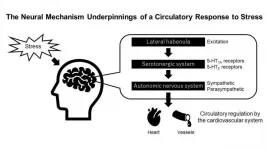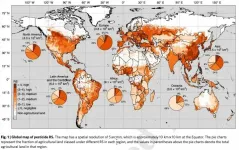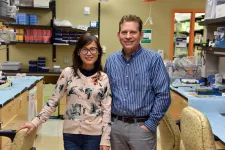The neural mechanism of a circulatory response to stress
Researchers from the University of Tsukuba discover a novel mechanism by which the brain regulates the cardiovascular system in response to stress
2021-03-30
(Press-News.org) Tsukuba, Japan - Although the heart beats autonomously, its function can be regulated by the brain in response to, for instance, stressful events. In a new study, researchers from the University of Tsukuba discovered a novel mechanism by which a specific part of the brain, the lateral habenula (LHb), regulates the cardiovascular system.
The cardiovascular system, specifically the heart and blood vessels, have a certain autonomy that allows them to function independently from the brain. In order for the individual to adapt to new, potentially threatening situations, the brain does have some regulatory power over the cardiovascular system. This is achieved by controlling the autonomic nervous system, which consists of the sympathetic and parasympathetic system. While the former has a stimulating effect on the cardiovascular system, including increasing the heart rate and blood pressure, the latter causes the opposite.
"From an evolutionary standpoint, the brain has had in incredibly important function in protecting the individual from predators," says lead author of the study Professor Tadachika Koganezawa. "But even in the absence of predators, our bodies react to stressful situations. In this study, we wanted to determine how the brain regulated the cardiovascular system via the autonomic nervous system."
To achieve their goal, the researchers focused on the LHb. Located deep within the brain, the LHb has been known to control behavioral responses to stressful events, and as such to elicit strong cardiovascular responses. However, the way in which it does so has remained unclear. To address this question, the researchers electrically stimulated the LHb in rats by inserting an electrode through the skull. Stimulation of the LHb resulted in bradycardia (low heart rate) and increased mean arterial pressure (MAP), which is a clinically useful parameter for assessing overall blood pressure.
To determine how the LHb interplays with the autonomic nervous system to regulate the cardiovascular system, the researchers then turned off the parasympathetic system by means of cutting the main parasympathetic nerve, the vagal nerve, or using a drug to antagonize it. While this suppressed the LHb's effect on the heart rate, it did not change the MAP. Antagonizing the sympathetic system did the opposite--it decreased the MAP but did not change the heart rate.
To understand the mechanism by which the LHb elicits these cardiovascular responses, the researchers focused on the neurotransmitter serotonin, which plays an important role in the brain in modulating mood, cognition, and memory, among other functions. While blocking all serotonin receptors significantly reduced the LHb's effect on both the MAP and heart rate, the researchers found that specific subtypes of serotonin receptors were particularly involved in the process.
"These are striking results that show how the lateral habenula controls the cardiovascular system. Our results demonstrate the mechanism of a neural circuit that plays an important role in stress-induced behavioral responses," says author of the study Professor Masayuki Matsumoto.
INFORMATION:
The article, "Lateral habenula regulates cardiovascular autonomic responses via the serotonergic system in rats" was published in Frontiers in Neuroscience at https://doi.org/10.3389/fnins.2021.655617.
[Attachments] See images for this press release:

ELSE PRESS RELEASES FROM THIS DATE:
2021-03-30
Primary sclerosing cholangitis (PSC) is a rare, chronic, inflammatory disease of the bile ducts and is difficult to treat, since its causes have not yet been adequately researched. Using RNA sequencing, an international research consortium led by Michael Trauner, Head of MedUni Vienna's Division of Gastroenterology and Hepatology (Department of Medicine III), has now succeeded in identifying a new prognostic factor for PSC from liver biopsies. This is so-called cellular ER stress. ER stress is the name given to a complex cellular response to stress caused by the build-up of misfolded proteins in the endoplasmic reticulum (ER).
PSC is a rare disease with a poor prognosis and can lead to cirrhosis ...
2021-03-30
In modern basic life science research as well as in drug discovery, recording and analyzing the images of cells over time using 3D microscopy has become extremely important. Once the images have been recorded, the same cell in different images at different time points has to be accurately identified ("cell tracking") because the living cells captured in the images are in motion. However, tracking many cells automatically in 3D microscope videos has been considerably difficult.
In the Kimura laboratory at the Nagoya City University, Dr. Chentao Wen and colleagues developed the 1st AI-based software called 3DeeCellTracker that can run on a desktop PC and automatically track cells in 3D microscope videos. ...
2021-03-30
Researchers have mapped the distribution of SARS-CoV-2, the virus that causes COVID-19, in deceased patients with the disease, and shed new light on how viral load relates to tissue damage.
Their study of 11 autopsy cases, published today in eLife, may contribute to our understanding of how COVID-19 develops in the body following infection.
More than 24 million SARS-CoV-2 infections have been reported to date, and the number of deaths attributed to COVID-19 has exceeded 828,000 worldwide. COVID-19 occurs with varying degrees of severity. While most patients have mild symptoms, some experience more severe symptoms and may need to be hospitalised. A minority of those in hospital may enter a critical condition, with respiratory failure, blood vessel complications, or multiple organ ...
2021-03-30
Recent studies indicate a link between children's cardiorespiratory fitness and their school performance: the more athletic they are, the better their marks in the main subjects - French and mathematics. Similarly, cardiorespiratory fitness is known to benefit cognitive abilities, such as memory and attention. But what is the real influence of such fitness on school results? To answer this question, researchers at the University of Geneva (UNIGE), Switzerland tested pupils from eight Geneva schools. Their results, published in the journal Medicine & Science in Sport & Exercise, show that there is an indirect link with cardiorespiratory fitness influencing ...
2021-03-30
Alloying, the process of mixing metals in different ratios, has been a known method for creating materials with enhanced properties for thousands of years, ever since copper and tin were combined to form the much harder bronze. Despite its age, this technology remains at the heart of modern electronics and optics industries. Semiconducting alloys, for instance, can be engineered to optimize a device's electrical, mechanical and optical properties.
Alloys of oxygen with group III elements, such as aluminum, gallium, and indium, are important semiconductor materials with vast applications ...
2021-03-30
It's no secret. Colorado's forests have had a tough time in recent years. While natural disturbances such as insect outbreaks and wildfires occurred historically and maintained forest health over time, multiple, simultaneous insect disturbances in the greater region over the past two decades have led to rapid changes in the state's forests.
A bird's eye view can reveal much about these changes. Annual aerial surveys conducted by the Colorado State Forest Service and USDA Forest Service have provided yearly snapshots for the state. New collaborative research led by Colorado State University and the University of Wisconsin-Madison now supplements this understanding with even greater spatial detail.
The ...
2021-03-30
A growing number of young people are identifying as part of the LGBTQ+ community, and many are challenging binaries in gender and sexual identity to reflect a broader spectrum of experience beyond man or woman and gay or straight. But not everyone is participating equally in these diverse forms of expression, according to new research from the University of California, Santa Cruz.
Psychology Professor Phillip Hammack's latest paper, published in the Journal of Adolescent Research, is shedding light on the social factors that can either hinder or support expression of diversity in sexual and gender identity ...
2021-03-30
The study, published in Nature Geoscience, produced a global model mapping pollution risk caused by 92 chemicals commonly used in agricultural pesticides in 168 countries.
The study examined risk to soil, the atmosphere, and surface and ground water.
The map also revealed Asia houses the largest land areas at high risk of pollution, with China, Japan, Malaysia, and the Philippines at highest risk. Some of these areas are considered "food bowl" nations, feeding a large portion of the world's population.
University of Sydney Research Associate and the study's lead author, Dr Fiona Tang, said the widespread use of pesticides in agriculture - while boosting productivity - could have potential implications for the environment, human and animal ...
2021-03-30
The latest gene editing technology, prime editing, expands the "genetic toolbox" for more precisely creating disease models and correcting genetic problems, scientists say.
In only the second published study of prime editing's use in a mouse model, Medical College of Georgia scientists report prime editing and traditional CRISPR both successfully shut down a gene involved in the differentiation of smooth muscle cells, which help give strength and movement to organs and blood vessels.
However, prime editing snips only a single strand of the double-stranded DNA. CRISPR makes double-strand cuts, which can be lethal to cells, and produces unintended edits at both the work site as well as randomly across the genome, ...
2021-03-30
HANOVER, N.H. - March 30, 2021 - Cyanobacteria living at the bottom of lakes may hold important, under-researched clues about the threat posed by these harmful organisms, according to a Dartmouth-led study.
The research, published in the Journal of Plankton Research, urges a more comprehensive approach to cyanobacteria studies in order to manage the dangerous blooms during a time of global climate change.
"Most studies of cyanobacteria focus on the times when they are visible in the water column," said Kathryn Cottingham, the Dartmouth Professor in the Arts and ...
LAST 30 PRESS RELEASES:
[Press-News.org] The neural mechanism of a circulatory response to stress
Researchers from the University of Tsukuba discover a novel mechanism by which the brain regulates the cardiovascular system in response to stress





